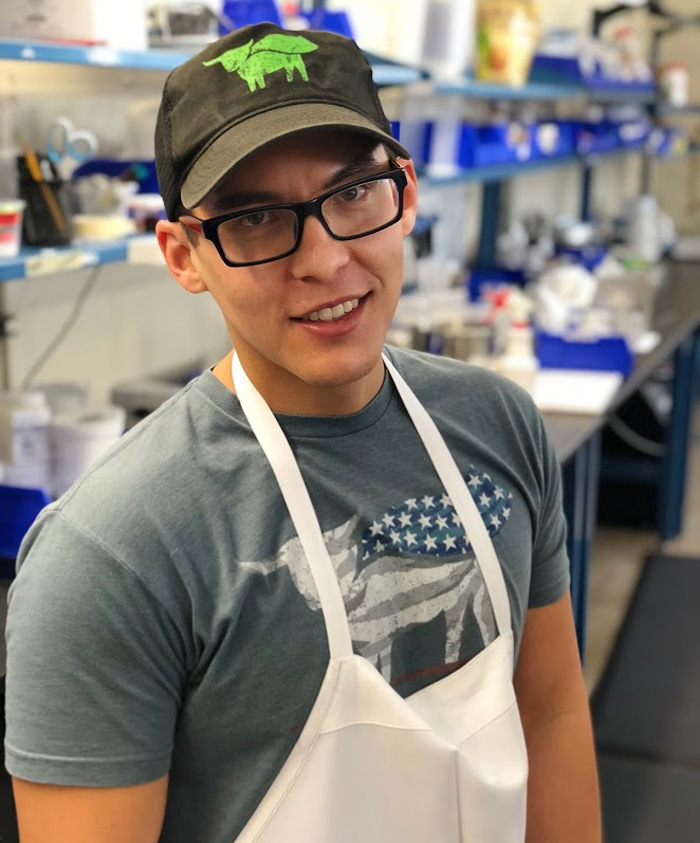
Meat the Future
The Chico State Autism Clinic utilizes adapted physical education to prep children for physical activity in a variety of settings.
Meat alternatives. Plant-based meats. These terms can elicit a range of emotions, from confusion to elation. Wherever you land on the spectrum, there’s no dispute that these products are popping up everywhere, from fine dining establishments to fast-food joints—and even at
The Happiest Place on Earth.
Impossible Foods ranked as the fourth fastest growing brand in the U.S. in 2019. And in its first day of trading in 2019,
Beyond Meat had the best debut session in the U.S. since 2008.
The American diet has been in the process of transitioning away from stick-to-your-ribs meat and potatoes for a number of reasons. Health is one. The environment is another. CSU alumni are at the forefront of this shift, using the skills they learned on campus to revolutionize the way we eat.
“Today’s consumers want to know what’s in their food,” says John Berriman, data scientist at Beyond Meat and an alumnus of
California State University, Fullerton and
California State University, Los Angeles. “They like to eat things they're proud of, as far as how it was sourced, how it was made and how it affects the planet. Beef is a primary contributor to global climate change. As far as [the increased popularity], I think it’s an intersection of health, animal welfare and reduction of usage of global resources. A lot of people can stand behind that.”

John Berriman, data scientist at Beyond Meat and an alumnus of Cal State Fullerton and Cal State LA.
In the past, meat alternatives just couldn’t compete with the real deal in terms of texture, taste and smell. But a whole host of companies are now offering consumers superior plant-based products.
“Seven to eight years ago, all the plant-based meat products were low in nutrition, low protein, high salt and were sold as frozen patties that loosely matched meat for texture and tasted like a salty bouillon cube,” says Tim Geistlinger, Ph.D., chief scientific officer at Perfect Day, former vice president of Research & Development at Beyond Meat and a California Polytechnic State University, San Luis Obispo alumnus.
“[At Beyond Meat], our strategy was to create a high protein ‘meat’ product that cooked, tasted and felt like meat, and would appeal to meat eaters, flexitarians and even some vegans and vegetarians. The goal was to create a choice for consumers that was good enough to force the question for every consumer, ‘This is so good, why should I continue to eat animal meat?’ And once they start to make the comparison, their choice would become more and more clear over time.”
“[Meat alternatives are] not just for vegans. They’re for anybody who wants to shift their diet toward something that agrees better with their biology, ethics and environmental goals.”
– John Berriman, data scientist at Beyond Meat, CSUF ’12/CSULA ’14
Berriman and Dr. Geistlinger both attribute their time at the CSU for instilling a passion for innovation. “I got to work with a diversity of scientists at various levels,” Berriman recalls. “It gets you in the mindset of collaborative and cross-functional teamwork that prepares an early scientist for a career later on.”
Geistlinger says Cal Poly San Luis Obispo opened his eyes to how amazing science is…and how hard it can be. “Cal Poly kicked my butt,” he says with a laugh. “It was difficult, but I learned the value of good, hard work. Cal Poly taught me I really did not know anything, and that that was OK because nobody else had all the answers, either. This gave me the confidence to get out in the world and try to do things others said were impossible. I think I have carried that fearless approach through the rest of my life and my career.”
Looking for a way to reduce your cardiac risk and/or carbon footprint? Try this recipe for Beyond Meat’s
Elote Burger.
Story: Michelle McCarthy
photoGRAPHY: PATRICK RECORD
Share this story